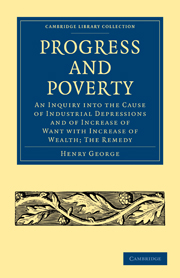 Progress and Poverty
Progress and Poverty Published online by Cambridge University Press: 07 September 2011
The manner in which increasing population advances rent, as explained and illustrated in current treatises, is that the increased demand for subsistence forces production to inferior soil or to inferior productive points. Thus, if, with a given population, the margin of cultivation is at 30, all lands of productive power over 30 will pay rent. If the population be doubled, an additional supply is required, which cannot be obtained without an extension of cultivation which will cause lands to yield rent that before yielded none. If the extension be to 20, then all the land between 20 and 30 will yield rent, and have a value, and all land over 30 will yield increased rent and have increased value.
It is here that the Malthusian doctrine receives from the current elucidations of the theory of rent the support of which I spoke when enumerating the causes that have combined to give that doctrine an almost undisputed sway in current thought. According to the Malthusian theory, the pressure of population against subsistence becomes progressively harder as population increases, and although two hands come into the world with every new mouth, it becomes, to use the language of John Stuart Mill, harder and harder for the new hands to supply the new mouths.
To save this book to your Kindle, first ensure [email protected] is added to your Approved Personal Document E-mail List under your Personal Document Settings on the Manage Your Content and Devices page of your Amazon account. Then enter the ‘name’ part of your Kindle email address below. Find out more about saving to your Kindle.
Note you can select to save to either the @free.kindle.com or @kindle.com variations. ‘@free.kindle.com’ emails are free but can only be saved to your device when it is connected to wi-fi. ‘@kindle.com’ emails can be delivered even when you are not connected to wi-fi, but note that service fees apply.
Find out more about the Kindle Personal Document Service.
To save content items to your account, please confirm that you agree to abide by our usage policies. If this is the first time you use this feature, you will be asked to authorise Cambridge Core to connect with your account. Find out more about saving content to Dropbox.
To save content items to your account, please confirm that you agree to abide by our usage policies. If this is the first time you use this feature, you will be asked to authorise Cambridge Core to connect with your account. Find out more about saving content to Google Drive.